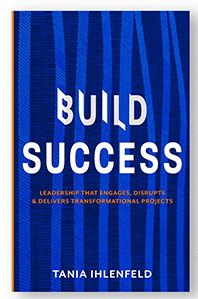
Overcoming 3 biggest obstacles at this time of year
The three biggest obstacles to project success at this time of year hold your team back from finishing the year strong and often lead to serious compromises that you’ll spend the next six months trying to undo.
The obstacles that I’m referring to are:
- Lack of time & resources
- Communication breakdowns
- Exhaustion & poor decision making
So what can you do to energise yourself, motivate your team and get the best out of the last dash toward end-of-year deadlines?
Lack of Time
I know that at this time of year and on really complex projects it feels as though priorities can shift by the hour if not by the minute. My plea for architects and project leaders is to set some intentions for how it is that they show up for the day, that week and across the month. The reason I say that, is that when you spend some time, for example, 30 mins every morning focusing on what it is that you need to do and how you are going to show up before you’ve looked at any emails and certainly before you have responded to anything. In my opinion, this will allow you to gain the perspective that you need to prioritise, focus your energy where it is best placed and support your team to do what they need to do.
If you need to head into an intense meeting, how are you going to prepare for that?
If you need to help your team members get something challenging across the line, how are you going to help them do this?
If you’ve set some intentions, when someone comes at you with a priority that you didn’t even see coming, something coming from completely left of field, you can stand back and get some much-needed perspective. With this perspective you can say, I hear you, that sounds urgent, but these are the things that I need to do today and this is what we need to do as a team. So, let’s regroup and revisit this either tomorrow or later in the week. Reiterating that I understand that it feels urgent to you, but this is the perspective, this is where we are going. This is what needs to be done, first, second and third.
When you come as a leader with that level of intentionality it will rub off on your team. Especially in terms of what they need to do and what they need to bring to the situation.
Another way to help prioritise is based on how well you manage expectations. By that I mean, managing up, sideways as well as down. But, beware of the time-consuming activity of just how much of your time is spent in meetings, or in conversations with people that are all too consuming.
It is with good intentions to want to share ideas and move things forward. If you’ve come in with the right intentions you can decide as a leader that this is not necessarily a meeting you need to be in. Or, that is precisely a meeting that you do need to be in to steer the ship and make sure the right decisions are made. So that the people in that meeting can go and have a productive afternoon afterward.
It is valuable to have these check-in moments when you assess how many meetings you need to be in. Be confident that you are putting the best interests of the project to heart when you are intentionally dedicating your time in this way.
Another one that I’ve fallen into so many times before as a leader . . .
When you can see the work ahead, you recognise how stretched your team is, so you decide to resourcefully find more resources to help. Sometimes when you do this at one of the most critical times of the year in terms of deadlines it can be the worst time to bring in new people.
It can mean that the existing team members need to stop what they are doing and bring someone completely new up to speed. Fair play, you could be bringing in someone with expertise in slotting into existing teams and they are very good at getting things done. Well done if you do! But understand that if you’re bringing in new team members in the midst of deadlines, ask yourself what support you’re going to provide for existing team members to onboard new members. Or can you create this new onboarding process that is partly offline from the rest of the team, led by you, where you onboard them without draining the existing resources?
Making sure that when new team members are being parachuted in that they have a clear understanding of who and where to ask for help.
Arguably, the onboarding process for team members to be brought in during an emergency is that much more crucial than under normal circumstances. Your team members will only thank you for adding resources if they get the right support to manage it appropriately.
Communication breakdown
The kind of breakdown that occurs when you lack time and resources, especially when deadlines are fast approaching. . .
There are many reasons for this, but the ones that really spring to mind are the fact there are too many layers that block the communication channels. Layers that convolute the really clear communication that needs to happen at this stage in the project.
Another key factor is that there are too many assumptions that go unsaid.
Whilst understandable when you are up against it in terms of time and resources, your team is in panic mode, or, the project has been running for a long period of time. It is still dangerous. You assume that everyone’s on board with an idea, you assume that the consultant or team member sitting across from you shares the same assumptions as you, and yet they don’t!
Another key area of concern relates to misaligned or misunderstood accountability.
Someone on your team may be communicating something with such conviction but they are not credible because they don’t have the accountability to say what they are saying. Or the opposite, someone is not communicating with conviction despite being accountable for it, because they should never have been assigned this level of accountability in the first place.
It can be so tempting to want to shortcut through the layers of communication channels on your project. Whilst tempting it can so easily put noses out of joint that it doesn’t save you any time in the long run.
Where it’s not possible to compress the number of layers to have a more straightforward conversation, I would urge you to get all of these layers in one room. Obviously, run this by your client. Explain the need to have all of the different layers understand where each other’s perspectives are coming from, go through key assumptions, and discuss responsibilities and accountabilities.
Ultimately, to gain an agreement on how you are all going to get this project across the line.
My challenge to design teams is when you’re going into these important meetings and presentations at this crucial time of year when major decisions need to be made, you ask yourself: what is the least amount of information that needs to be produced to get the right decisions made?
Designers should think about the minimum they could write down, which needs to be understood by the decision-makers and only then seek to back that up with visual information.
And if you are from the technical team, what is the minimum visual information that could be produced to convey what needs to be essentially communicated and then back this up with technical evidence, what might this look like?
Of course, I’m deliberately shifting things around as it would normally be the opposite. But by challenging you to do the opposite it means that you’ll really think about what needs to be communicated. Although it might not be initially comfortable, it will mean that you stay focused on delivering the essential messaging and information that decision-makers need.
Exhaustion & Poor Decision-Making
It’s perfectly natural to assume that as we approach the end of the year, especially if it has been a tough year, that exhaustion has kicked in. Although you hope that your team has taken a break during the year, you find out at this time of year if it’s been adequate!
I believe your job as a leader is to recognise that there will be certain people on your team who are more exhausted than others, and some are caught on a relentless treadmill.
I have found that the only people who can take a person off a treadmill are the leaders in charge or someone other than the person themselves. I’ve been in this situation before where you honestly feel as though you can’t get off the treadmill because if you do you will drop the ball. Something will be missed, and you will disappoint your team in some way.
You need someone to literally pick you up off the treadmill, set you aside and help you regroup. You will need to catch the fallout, especially if someone has been stuck on this treadmill for a long period of time. Things will have slipped through the net and they are not going to have been as productive and creative as you need them to be.
But by supporting the fallout and helping them to regroup, you will see that they will become more productive.
Others on your team will see that we can’t operate like this. Instead, we need to be performing as a team and that means supporting each other. Projects are not a single effort.
If it’s you as a leader on the treadmill, then you need to ask someone to lift you off it!
One of the most effective ways to avoid this exhaustion treadmill and certainly the longevity of it is to regularly check in with the project’s priorities, for you and for your team.
I’m sure you are doing this, but if you’ve typically been reviewing these once a week you may need to shift to daily during intense periods of work. Look at how much time you can carve out for this to make sure that it happens. How much of this burden can you share with your leadership team if you’re lucky enough to have support around you?
How can you help your team work out what’s best to reprioritise, without flip-flopping? Because this is just as exhausting as not making any decisions.
Use the premise that you should aim to produce the least amount of information at the highest quality possible to help decision-makers. Whilst also protecting the design elements that are most crucial for your project.
It’s an easy trap to fall into, to want to overdeliver for a client. Producing absolutely everything just in case it is helpful for decision-makers or just in case it is the thing that carries your project across the line . . . BUT, are you really delivering for your client if decision-makers are not able to see the right information to base their decisions on because there is too much of it?
Use your judgement here. You want to service your client in the best way possible.
I believe that this is by giving your client the highest quality information based on what they genuinely need.
One final point regarding poor decision-making . . .
If you’re finding that decision-making has just stalled. People don’t seem to be willing to get around the table and really look at the issues at hand and make tough decisions, then I would urge you to muster up the energy to talk about the vision. I know this might sound exhausting. But, it is honestly a means to supercharge decision-making.
I appreciate that when you’ve got some technical issues and you’re up against it in terms of time and resources, talking about the vision might feel like the last thing you should do. Sometimes it needs to be via stealth but other times it can and should be out in the open because everyone should feel ownership towards it. The vision can help to energise your team, your client and your stakeholders.
If your team can see how they are able to contribute to it, it will help them get behind it.
Likewise, when your client can see how their needs and agendas are being met with this vision, and you’re reminding them of this in critical moments, it will help to focus efforts.
If you would like help streamlining decision-making or managing expectations on your project and within your teams book a call with me to see how I can make your leadership role more effortless and enjoyable. I have written a book - BUILD SUCCESS - that is intended as a pragmatic blueprint to support courageous leaders in pursuit of high-quality project outcomes. Our industry has some amazing opportunities and challenges ahead, that can use our collective wisdom. You can book a call, check out my new book, plus learn more about our resources and services with the links below.
Enabling your success!



